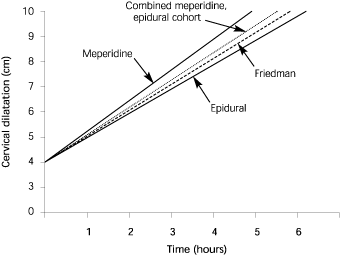
Am Fam Physician. 2002;66(10):1960
The classic Friedman curve of cervical dilatation has been used since 1954 to define normal progression during labor. Deviations from the curve are perceived as indicating dysfunctional labor and are frequently attributed to dystocia, leading to cesarean delivery. Alexander and colleagues studied the effect of epidural analgesia on the Friedman labor curve.
They studied the labors of 459 healthy nulliparous patients with singleton cephalic presentations at term at a university hospital in Texas. The mothers were randomly assigned to either patient-controlled epidural analgesia or intravenous meperidine, also patient-controlled. All labors were supervised using established protocols. Pelvic examinations were performed at least every two hours to document the progress of labor. Indications for oxytocin augmentation and forceps use were the same for all patients. The beginning of the active phase of labor was defined as a change in cervical dilatation commencing with dilatation of 3 cm on admission. Complete cervical dilatation defined the onset of the second phase of labor. For each patient, the rate of cervical dilatation was calculated as centimeters per hour.

The 226 mothers assigned to epidural analgesia were not significantly different from the 233 mothers assigned to intravenous meperi-dine. Although the rate of cesarean delivery was similar in each group (5 percent for epidural, 6 percent for meperidine), the rates of oxytocin augmentation and forceps delivery were significantly higher in mothers receiving epidural analgesia. In the epidural group, oxytocin was used in 44 percent of mothers, compared with 32 percent in the meperidine group. The rate of forceps delivery was 12 percent with epidural compared with 3 percent with intravenous meperidine. The active phase of labor averaged 6.0 ± 3.2 hours with epidural, compared with 5.0 ± 3.2 hours with meperidine. The duration of the second stage of labor was also longer in the epidural group, but the difference was not statistically significant.
The authors conclude that epidural analgesia significantly slows the active phase of labor and is associated with increased use of oxytocin and forceps. They caution that this delay could be interpreted as dystocia and result in cesarean delivery. They call for wider recognition of the epidural's effects on labor by all delivering physicians (see the accompanying figure).